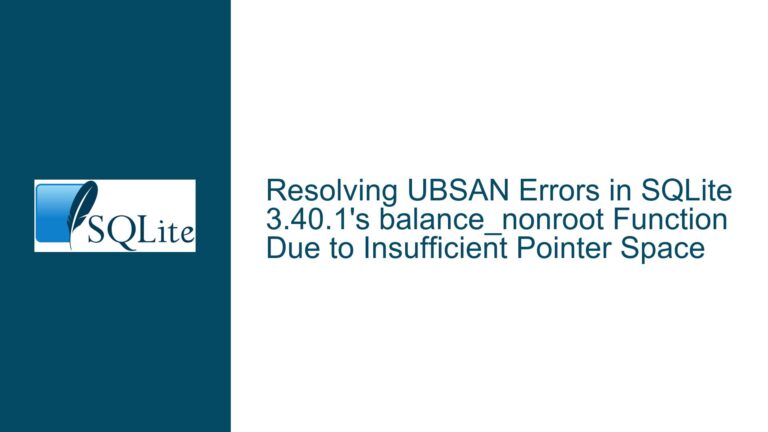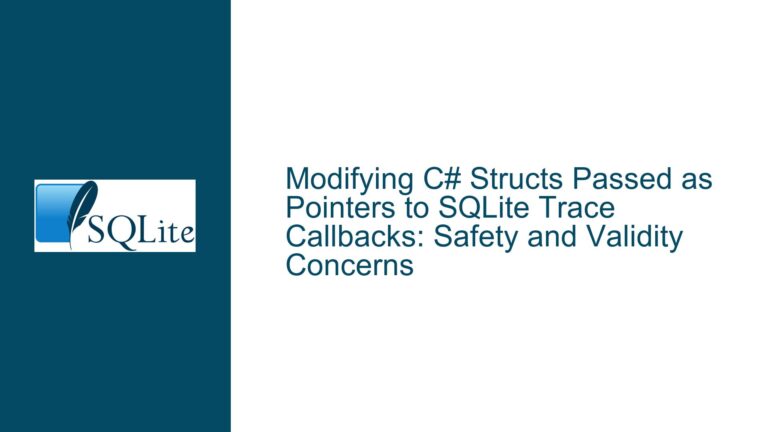Segmentation Fault When Closing SQLite Database Within a Transaction
Issue Overview: Segmentation Fault During Database Closure Within a Transaction
The core issue revolves around a segmentation fault that occurs when attempting to close an SQLite database connection while a transaction is still active. This fault is triggered specifically in a debugging environment, where both SQLite and Tcl are built with debugging symbols enabled. The fault manifests when executing a Tcl script that initiates an in-memory SQLite database, starts a transaction, and then attempts to close the database connection within the same transaction block.
The segmentation fault is a critical error that indicates the program attempted to access an invalid memory location, often due to improper handling of resources or state inconsistencies. In this context, the fault arises because the database connection is being closed while the transaction is still in progress, leading to an undefined state in the SQLite library. This scenario highlights a fundamental conflict between the lifecycle of a database connection and the lifecycle of a transaction.
The transaction, by design, requires an active database connection to either commit or roll back changes. When the database connection is closed prematurely, the transaction is left in an unresolved state, causing the SQLite library to attempt operations on a now-invalid connection. This results in the segmentation fault. The issue is further compounded by the Tcl binding’s behavior, which may not adequately handle the cleanup of transactions during database closure.
Possible Causes: Resource Management and State Inconsistencies
The segmentation fault can be attributed to several underlying causes related to resource management and state inconsistencies within the SQLite library and its Tcl binding.
First, the premature closure of the database connection within a transaction block violates the transactional integrity guarantees provided by SQLite. Transactions are designed to be atomic, consistent, isolated, and durable (ACID). Closing the database connection before finalizing the transaction disrupts these guarantees, leaving the transaction in an indeterminate state. This inconsistency can lead to undefined behavior, including segmentation faults.
Second, the Tcl binding for SQLite may not properly handle the cleanup of resources associated with an active transaction when the database connection is closed. The binding is responsible for managing the lifecycle of database connections and transactions, ensuring that all resources are properly released and that transactions are either committed or rolled back before the connection is closed. If the binding fails to perform these tasks, it can result in resource leaks or invalid memory accesses, leading to segmentation faults.
Third, the debugging builds of both SQLite and Tcl may expose additional issues that are not apparent in release builds. Debugging builds often include additional checks and assertions that can reveal subtle bugs or inconsistencies in the code. In this case, the segmentation fault may be triggered by an assertion or check that validates the state of the database connection and transaction. If the state is found to be invalid, the debugging build may intentionally trigger a segmentation fault to alert the developer to the issue.
Finally, the issue may be exacerbated by the use of an in-memory database. In-memory databases have different lifecycle and resource management characteristics compared to file-based databases. The transient nature of in-memory databases means that resources are typically allocated and deallocated more frequently, increasing the likelihood of resource management errors. Additionally, the lack of a persistent storage medium means that transactions must be handled with even greater care to ensure data integrity.
Troubleshooting Steps, Solutions & Fixes: Resolving the Segmentation Fault
To resolve the segmentation fault, several steps can be taken to address the underlying causes and ensure proper resource management and state consistency.
First, it is essential to ensure that all transactions are properly finalized before closing the database connection. This can be achieved by explicitly committing or rolling back the transaction before calling the close method on the database connection. In the context of the Tcl script, this would involve modifying the code to explicitly finalize the transaction before closing the database. For example:
package require sqlite3
sqlite3 db :memory:
db eval {BEGIN TRANSACTION}
# Perform database operations here
db eval {COMMIT}
db close
By explicitly committing the transaction before closing the database, the script ensures that the transaction is properly finalized and that the database connection is in a valid state when it is closed.
Second, the Tcl binding for SQLite should be reviewed and potentially modified to handle the cleanup of resources associated with active transactions when the database connection is closed. This may involve adding additional checks and cleanup routines to ensure that all transactions are either committed or rolled back before the connection is closed. The binding should also ensure that all resources associated with the transaction, such as prepared statements and cursors, are properly released.
Third, the debugging builds of SQLite and Tcl should be used to identify and address any additional issues that may be contributing to the segmentation fault. Debugging builds often include additional checks and assertions that can help identify subtle bugs or inconsistencies in the code. By running the script in a debugging environment, developers can gain additional insights into the root cause of the segmentation fault and take steps to address it.
Fourth, the use of in-memory databases should be carefully considered, especially in scenarios where transactions are involved. In-memory databases have different resource management characteristics compared to file-based databases, and developers should be aware of these differences when designing and implementing their applications. In particular, developers should ensure that transactions are properly finalized and that resources are properly managed to avoid issues such as segmentation faults.
Finally, the fix provided by Dan Kennedy, as referenced in the discussion, should be reviewed and applied if applicable. The fix, available at https://www.sqlite.org/src/info/e54a33ce56432b23, addresses the specific issue of segmentation faults occurring when closing a database connection within a transaction. By applying this fix, developers can ensure that the SQLite library properly handles the cleanup of resources and maintains state consistency, even in scenarios where the database connection is closed within a transaction.
In conclusion, the segmentation fault when closing a database within a transaction is a critical issue that can be resolved by ensuring proper resource management and state consistency. By explicitly finalizing transactions, reviewing and modifying the Tcl binding, using debugging builds to identify additional issues, carefully considering the use of in-memory databases, and applying relevant fixes, developers can address the underlying causes of the segmentation fault and ensure the stability and reliability of their applications.






